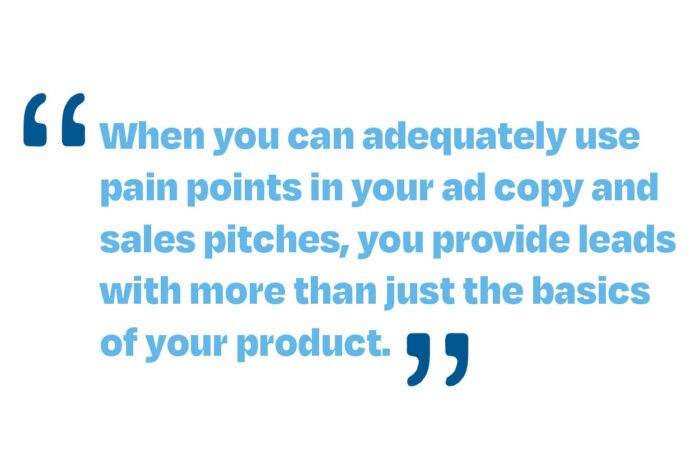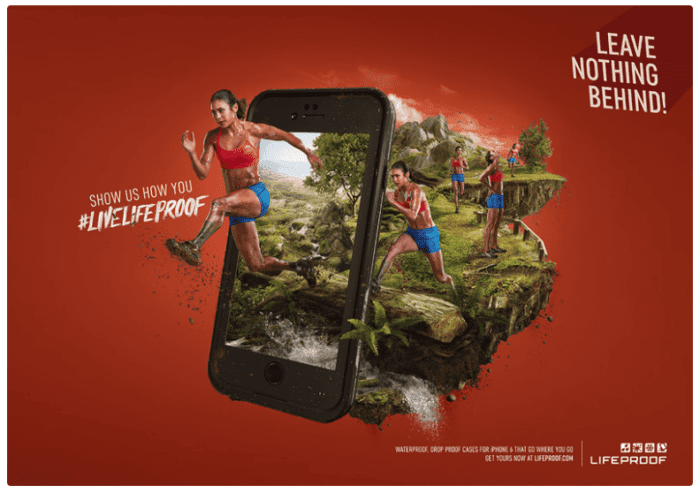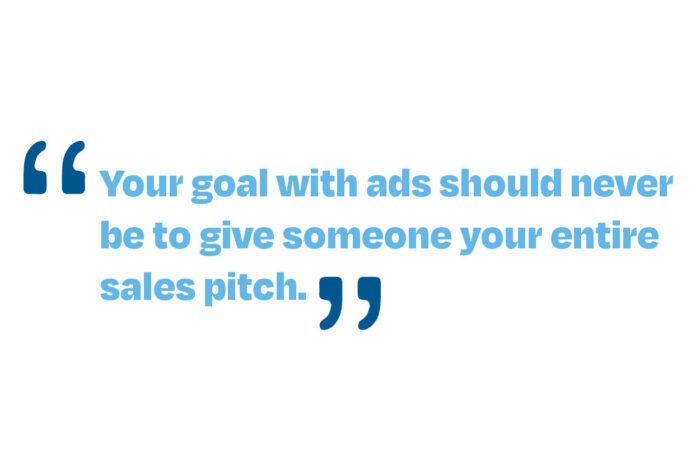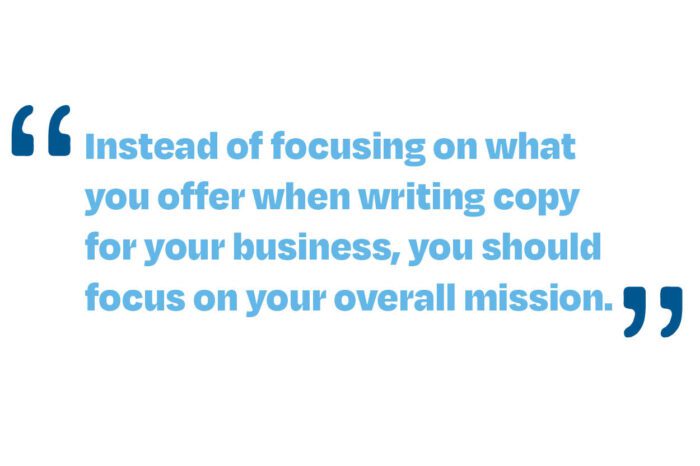If you’re like many entrepreneurs across the country, your copy probably stinks. That’s because most business owners lack the formal training necessary to write compelling copy that sells. But not to worry, we have you covered. This is your complete guide on how to improve your copywriting, start making sales, and supercharge your profits.

Focus On The Pain Points.
There’s an old saying in sales that goes something like this:
“Selling is not about convincing someone to buy something they don’t need. It’s about understanding people’s problems and explaining how you can provide the solution.”
In other words, your goal in selling should never be to steamroll someone into buying some useless garbage they don’t need. It should be about helping them solve their problems through your products and services — and your copy should always reflect that goal.
For example, suppose you’re selling mattresses. Your first thought should be, “Who needs a mattress, and where do I find them?” That will help you to get into the mindset of your ideal customer.

Now, suppose you must write a 2-sentence marketing ad for your mattresses. You create 3 drafts with the following copy:
- “Mattress Emperor offers competitive prices you won’t find anywhere else. Save 20% on full-size mattresses and 30% on king-size when you use promo code ‘SLEEP’ at checkout.”
- “At Mattress Emperor, our mattresses are the most comfortable in the business. Explore various options and save big when you make the switch.”
- “If you’re like 50% of Americans, your mattress is a certified sleep-ruiner. Stop waking up exhausted and learn the true meaning of rest when you purchase a mattress tailored to your needs at Mattress Emperor.”
Now, which of these ads is the most compelling?
#1 is decent if all you’re hoping to communicate is your promotion. It’s unlikely to convert the average person to a valid lead, but hey, at least they will know that mattresses are 20%–30% off.
#2 explains that your mattresses are comfortable. But isn’t it a given that mattresses are supposed to be comfortable? Run this ad if you’re happy to blend in with every other mattress seller saying the same thing.
#3 is the only ad that addresses why a consumer might need a new mattress — subpar sleep quality. Every other ad focuses on explaining what you sell, not how it will improve the customer’s life.

When you can adequately use pain points in your ad copy and sales pitches, you provide leads with more than just the basics of your product. You will give them a compelling reason why you can improve their overall quality of life, which is much more impactful if you want to boost overall sales numbers.
Create A Sense Of Urgency.
Some things in life are more urgent than others. For example, suppose you wake up one morning to the sound of the fire alarm. As you’re fleeing with your pets and loved ones, you see the sink full of dirty dishes.
Are you going to stop to do those dishes? Absolutely not. You are dealing with something more pressing that demands your immediate attention.
So, how does that apply to marketing? And what does it have to do with learning how to improve your copywriting?
While it’s nearly impossible to create all-consuming life-or-death urgency within your marketing copy, it is life or death. If your business can’t develop effective sales and marketing materials that convert potential leads into paying customers, you’re just one bad fiscal year from collapsing.
The average person sees 4,000–10,000 ads every day. Consumers aren’t just used to it — they’re completely desensitized. Unless they leave to live on a deserted island, constant bombardment with marketing drivel will always be part of their lives.

That means to capture someone’s attention in the first place, you need to provide something that stands out from the norm.
So, how do you do that?
First, you identify what their worst-case scenario is. Unlike a pain point, it doesn’t have simple solutions and creates more pressing problems. People tend to fear loss, so you should start zeroing in on what your clients stand to lose.
For example, let’s say you work for a home insurance company. What is the worst-case scenario for homeowners without insurance?
They could lose their homes to a disaster and not have the money to fix it. So, if you were trying to write compelling copy for this business, you could start with a straightforward statement.
“Without home insurance, you’re one storm away from financial ruin.”
While this is an easy example, many businesses have selling points like this. If appropriate, they should be using them. And this is a great place to start if you’re interested in understanding how to improve your copywriting.
To be clear, this tactic can also backfire if not executed carefully. That’s why you need to be conscious of what you’re saying and how you’re saying it. The goal should never be to lie or induce cataclysmic thinking. It should show consumers the sobering reality of their choices and push them to make better decisions in the long run.
Add Intrigue.
Curiosity can be a powerful thing when it comes to supercharging your marketing copy.
That means less is more.
Many marketers mistakenly think their entire sales pitch belongs in their ad copy. They write paragraph after paragraph, then shove that copy into pamphlets, billboards, magazine ads, etc.
Nobody is going to read that.

Your goal with ads should never be to give someone your entire sales pitch. That’s what your landing page is for. Your ad copy should get consumers into the sales funnel and encourage them to act upon your initial call to action.
But what does that look like in practice?
To illustrate, let’s explore an example. Let’s say you’re running a haunted house and passing out pamphlets around your local community. You could say:
“Our haunted house is the creepiest in the tri-state area. Located in a historic abandoned school building, we have garnered great reviews in multiple local magazines — including the Metropolitan Observer. Fun for the whole family, this attraction is perfect to put you in a Halloween mood. Tickets start at $20 for adults and $10 for children. We hope to see you there!”
If you think most people will read that wall of text, you’re wrong. Contrastingly, keep it simple with one of the following lines.
- “Face your fears.”
- “Will you make it out alive?”
- “Here, nobody can hear you scream.”
- “Something’s lurking in the shadows …”
- “There’s someone in the house …”
Of course, these lines cannot function on their own. All ad copy should be accompanied by a design that alludes to what you are selling and contains a QR code readers can use to access your website. In this case, a shadowy image of the haunted house with the business logo at the bottom will give readers an idea of what they can expect. Just ensure the design is visually appealing, as it is as influential as the copy when it comes to the performance of ads.
If you rely more on building intrigue than giving a sales pitch, you are much more likely to convert readers to potential customers.
Focus On The ‘Why.’
As Simon Sinek, American author and motivational speaker, once said, “People don’t buy what you do — they buy why you do it.” But what does that mean?
Instead of focusing on what you offer when writing copy for your business, you should focus on your overall mission: why you do what you do and emphasizing the deeper meaning of your company’s story if you want to inspire consumers to act.

Most companies sell their business in the exact opposite order than they should. They start with their “what,” move on to their “how,” and finish with their “why.” Instead, they should start with their “why” and allow their “what” and “how” to serve as natural outgrowths of their central mission.
For example, if you run a shoe company that uses recycled materials removed from the oceans, you can write copy for your company in 1 of 2 ways: focusing on what or why. If you were to focus first on your products, you would likely write something like this:
“At WaveWalkers, we specialize in creating beautiful, comfortable footwear for people of all ages. All our materials are recycled from garbage removed from our oceans. That’s because we believe in the power of tomorrow and are confident we can leave our children with a cleaner world — one step at a time.”
Now, there’s nothing outwardly wrong with this copy. It explains your purpose as a company clearly. However, if you want to improve your copywriting, you can’t stop at “good enough.”
Here’s what happens when you focus on “why”:
“At WaveWalkers, we believe in the power of tomorrow and are confident we can leave our children with a cleaner world. That’s why we are committed to using recycled materials removed from our oceans in our products. These materials have allowed us to create beautiful, comfortable footwear for people of all ages while helping to save our planet — one step at a time.”
Not only is starting with why more impactful, but it also helps you to center the rest of your copy around your central mission.
Write Like Your Audience Talks.
Sometimes in the business world, it’s easy to get caught up in the trap of always needing to be professional. We get used to using acronyms, formalities, and legalese — and sometimes, that bleeds into our copy.
Here’s the thing: Everyday people don’t respond to that.
And it’s not because they don’t understand it — they usually do. It just sounds pompous and ridiculous to them. They don’t want to hear pretentious nonsense that makes them feel like they’re talking to a first-year Ivy League English major. They want to feel seen and respected as consumers.
For example, suppose you run a social media marketing company. On your website, you use the following copy:
“At FoKus, we’re illuminating the path to digital enlightenment via avant-garde social media marketing. Our elite team is comprised exclusively of sophisticated digital socialites and tastemakers who know how to elevate any business. We’re more than just a social media company. We’re on the front lines of online marketing, shaping an industry and putting more pedestrian forms of our craft to rest.”
And sure, that might be compelling ad copy if your goal is to market to elitists exclusively, but that’s a small pool of buyers. It also sounds annoying and unbelievably condescending.
Or you could fall into the trap of assuming everyone speaks business jargon. You could also write something unintelligible like this:
“FoKus is an SMM company all about supercharging your ROI. We aim to use social media to reduce CAC and boost your customer LTV. We use original and UGC to instill FOMO in your audience, and our CTAs get results.”
Once again, this is worlds apart from how the average customer speaks. Most people outside of the marketing world wouldn’t understand this copy on a first read-through without using Google. While this is an exaggerated example, it’s not far from how marketers can get caught up in using abbreviations and technical terms in their copy.
Nobody wants to read copy that sounds snobby or like a weird acronym-spouting robot wrote it. They want to feel like they are communicating with a person. If you want to learn how to improve your copywriting, focus on what resonates with your audience and mirrors their communication preferences.
So, now that you know how to improve your copywriting, it’s time to get out there and do it.
If you want to learn more about how writing can enhance your business success, we encourage you to download our Content Marketing Guide.



Recent Comments